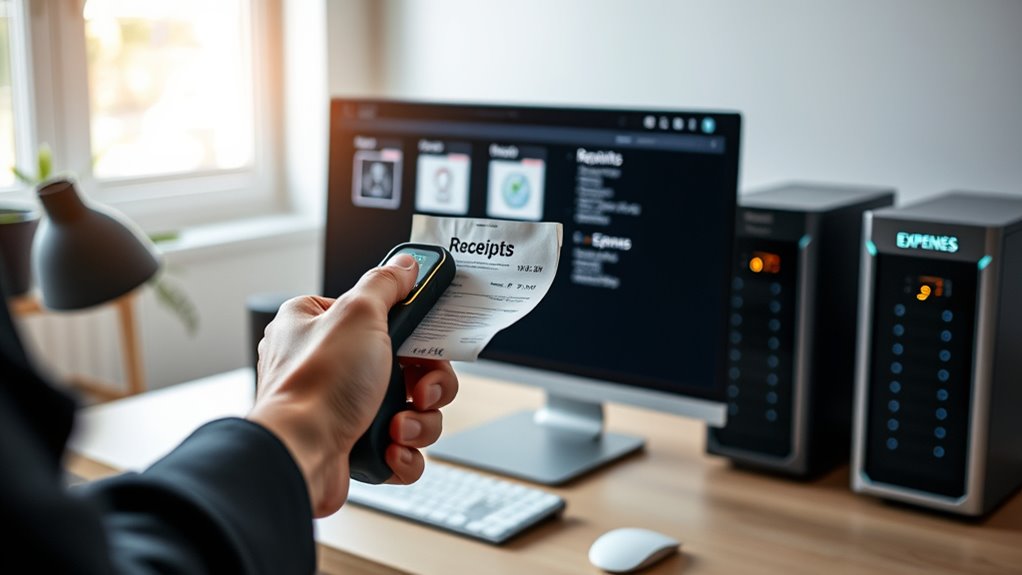To organize your digital receipts with OCR and home-server automation, start by choosing accurate OCR tools like ABBYY FineReader or Tesseract, and set up a home server running a stable OS such as Linux. Automate receipt collection from emails or cloud storage, and use scripts to extract data, categorize, and securely store information. Regular maintenance and scalability guarantee efficiency, and if you keep going, you’ll discover detailed steps for building a seamless, long-term system.
Key Takeaways
- Implement OCR tools like ABBYY FineReader or Tesseract to digitize and extract data from scanned receipts.
- Use home-server automation to automatically sort, categorize, and backup digital receipts.
- Establish a structured storage system with encrypted cloud or local drives for easy retrieval.
- Set up scripts to automatically fetch receipts from emails or cloud services for continuous organization.
- Regularly update and maintain OCR and automation systems to ensure accuracy and adapt to evolving needs.
Understanding OCR Technology and Its Benefits for Receipt Management
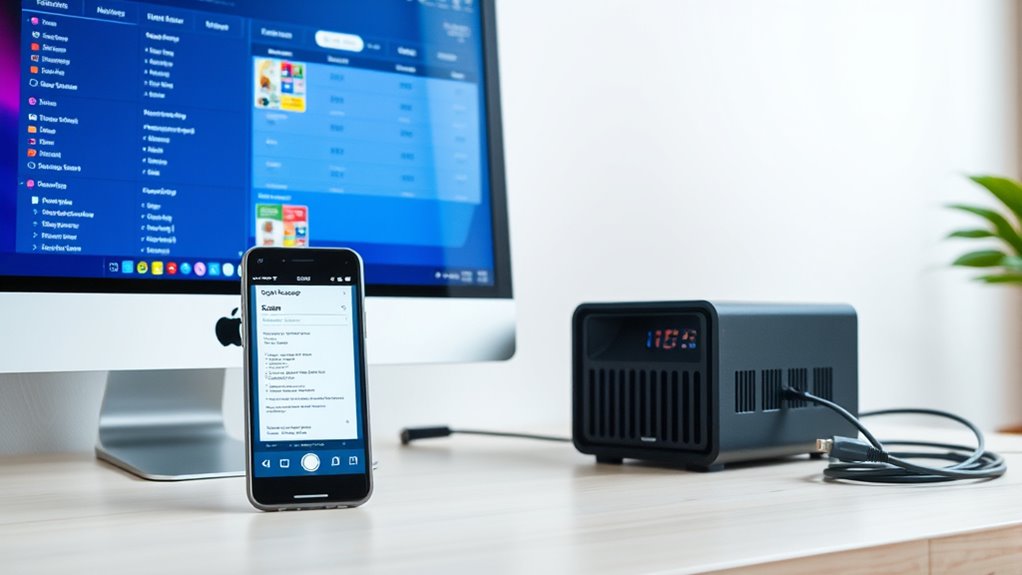
Optical Character Recognition (OCR) technology has revolutionized how you manage digital receipts by transforming scanned images into editable, searchable text. With OCR, you can quickly convert a paper receipt or a scanned image into a digital format that’s easy to organize and search. This saves you time since you no longer need to manually input data or sift through images. OCR also improves accuracy by extracting details like dates, amounts, and vendor names, making it easier to categorize and track expenses. Plus, it enables seamless integration with financial software or home-server systems, so your receipts become part of a streamlined digital archive. Overall, OCR simplifies receipt management, helping you stay organized and reducing clutter in your digital and physical spaces. Considering various features of OCR, you can choose the most suitable solution to enhance your receipt organization process.
Selecting the Right OCR Tools for Your Needs

Choosing the right OCR tool depends on your specific needs and workflow. If accuracy is your top priority, opt for advanced options like ABBYY FineReader or Adobe Acrobat, which excel at recognizing complex layouts and handwriting. For quick, everyday tasks, free or open-source tools like Tesseract or Google Keep might suffice. Consider the types of receipts you’ll process—if they’re mostly clear and simple, basic OCR tools work well. If you handle receipts with multiple languages or unusual fonts, select tools with multilingual support. Also, assess how well the software integrates with your existing systems, like cloud storage or automation workflows. Finally, check for features such as batch processing, editing, and exporting options, which can streamline your receipt management and improve efficiency. Additionally, understanding color accuracy can help you choose OCR tools that better recognize text in images with varied lighting or color conditions.
Setting Up a Home Server for Automation Tasks

Setting up a home server can considerably streamline your receipt management process by automating tasks like sorting, storing, and extracting data. It serves as a central hub, making your workflow more efficient. To start, choose hardware that suits your needs—whether a dedicated mini PC or repurposed old hardware. Install an operating system like Linux for stability and flexibility. Next, set up automation tools such as automation scripts or platforms like Home Assistant. This allows you to schedule tasks, manage files, and run OCR processes seamlessly. Remember, a well-configured server enhances security and reduces manual effort. Key points to examine include:
- Ensuring sufficient storage capacity
- Setting up remote access for convenience
- Automating backups for data safety
- Prioritizing security and trustworthiness to safeguard your data
Automating Receipt Collection From Email Accounts and Cloud Storage

Automating receipt collection from email accounts and cloud storage simplifies the process of gathering your digital receipts. By setting up automated scripts or tools, you can regularly scan your email inbox for purchase confirmations and receipts, automatically downloading attachments or saving relevant emails. Similarly, cloud storage services like Dropbox or Google Drive can be integrated to automatically sync new receipts as they arrive. This eliminates manual searches and downloads, saving you time and reducing the chance of missing important documents. You can configure filters to target specific email senders or keywords, ensuring only relevant receipts are collected. Incorporating industry trends into your automation setup helps keep your system efficient and up-to-date. With these automations in place, your digital receipt collection becomes seamless, allowing you to focus on organizing and processing the data rather than gathering it.
Extracting Data From Receipts Using OCR
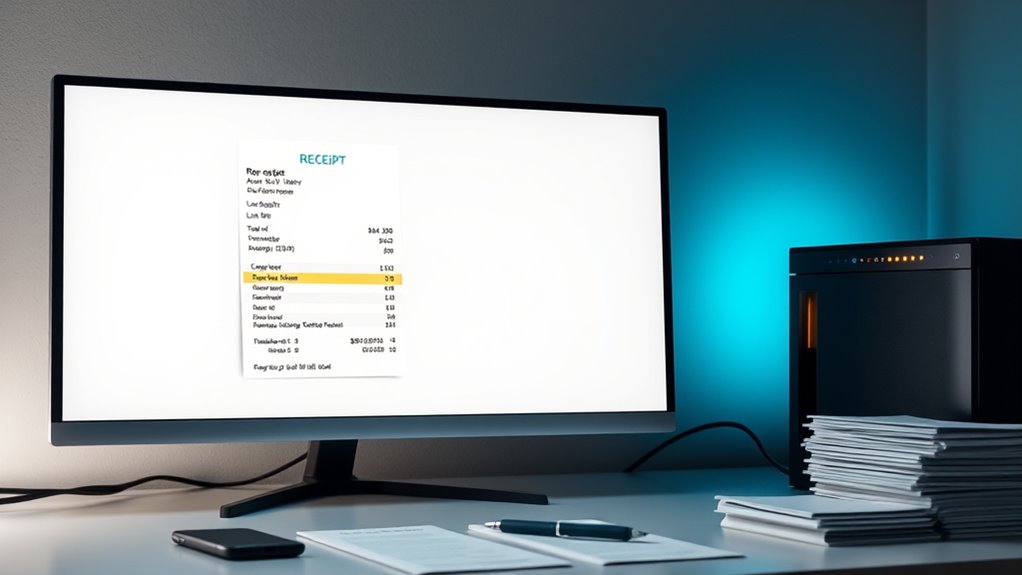
When selecting OCR tools, you need options that balance ease of use with accurate data extraction. Keep in mind that receipt variability—such as layout, fonts, and image quality—can impact performance. Addressing these factors ensures you get reliable results from your OCR process. Additionally, incorporating user reviews and feedback can help identify tools that perform well across diverse receipt formats.
Choosing OCR Tools
Choosing the right OCR (Optical Character Recognition) tool is vital for accurately extracting data from your digital receipts. You want software that balances accuracy, speed, and ease of use. Consider tools with support for multiple languages if you handle receipts in different languages. Compatibility with your operating system is also essential to guarantee smooth integration into your workflow. Look for features like batch processing and adjustable image preprocessing to improve results. Some popular options include open-source solutions, commercial software, and cloud-based services. Additionally, understanding the side effects of juice detox can inform your approach to health and wellness, which may be relevant when managing dietary receipts or health-related expenses.
Data Extraction Accuracy
How precisely your OCR software extracts data from receipts directly impacts the reliability of your digital record-keeping. If the software misreads prices, dates, or merchant names, your records become unreliable, making it harder to track expenses or file taxes. High accuracy depends on choosing the right OCR tools, which use advanced algorithms to interpret varied fonts, layouts, and image qualities. You should verify the extracted data against the original receipt, especially for critical fields like totals and dates. Improving accuracy might involve preprocessing images—like sharpening or cropping—to enhance readability. Remember, even the best OCR isn’t perfect; some manual correction is often necessary. Prioritizing accuracy ensures your digital receipts serve as trustworthy financial records and simplifies subsequent data management tasks. Recognizing the individual responses of your OCR software helps you identify and correct errors more effectively.
Handling Receipt Variability
Dealing with the variability in receipts is a key challenge when extracting data using OCR. Receipts differ in layout, fonts, and quality, which can hinder accurate data recognition. To improve results, you need to account for these differences by customizing your OCR approach. Preprocessing images—like adjusting contrast, cropping, or removing noise—helps enhance recognition. Additionally, training your OCR model on diverse receipt samples boosts its adaptability. Keep in mind that:
- Different vendors use various formats and fonts, requiring flexible parsing algorithms
- Low-quality images can lead to misreads, so capturing clear scans is critical
- Implementing error correction and validation checks improves data accuracy
- Maintaining an awareness of small mistakes can help you identify and rectify OCR errors more effectively
Organizing and Storing Extracted Receipt Data Efficiently
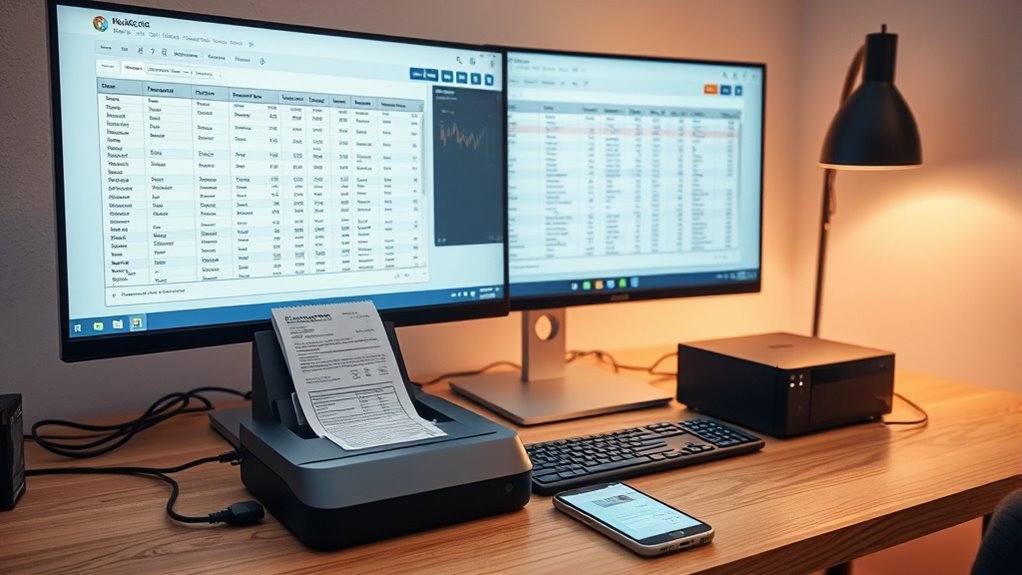
To keep your receipt data organized, you need to choose the right data formats that make retrieval easy and consistent. Secure storage solutions are essential to safeguard sensitive information from theft or loss. By combining structured formats with reliable storage, you’ll ensure your receipts are both accessible and safe. Incorporating cultural significance into your organization process can also help tailor your system to specific needs or preferences.
Structured Data Formats
Choosing the right structured data format is essential for organizing and storing extracted receipt data efficiently. The format you select influences data retrieval, compatibility, and future scalability. Popular options include JSON, XML, and CSV, each suited for different needs. JSON is flexible and easy to read, making it ideal for complex data with nested elements. XML offers strict schema validation, useful for standardized data exchange. CSV is simple and lightweight, perfect for tabular data but limited in scope. When selecting, consider ease of integration with your automation tools, storage space, and the complexity of your receipt data. Proper formatting ensures quick access, accurate sorting, and seamless data analysis. Additionally, understanding structured data formats helps optimize how you handle diverse receipt information within your system.
Secure Storage Solutions
Effective secure storage solutions are essential for protecting your digital receipt data from unauthorized access and potential breaches. You should choose encrypted cloud services or local backups with strong security measures. Regular updates and access controls help prevent vulnerabilities. Consider using dedicated storage devices like NAS or encrypted external drives for added safety. Organizing your data with clear folder structures and consistent naming conventions improves retrieval and management. Here’s a quick overview:
| Storage Method | Security Feature | Suitability |
|---|---|---|
| Cloud Storage | End-to-end encryption | Remote access, backups |
| NAS | User authentication | Local, large volume |
| External Drive | Hardware encryption | Offline, portable |
Selecting the right solution depends on your needs for accessibility, security, and capacity. Combining methods offers extensive protection.
Integrating OCR and Home Server Automation for Seamless Workflow
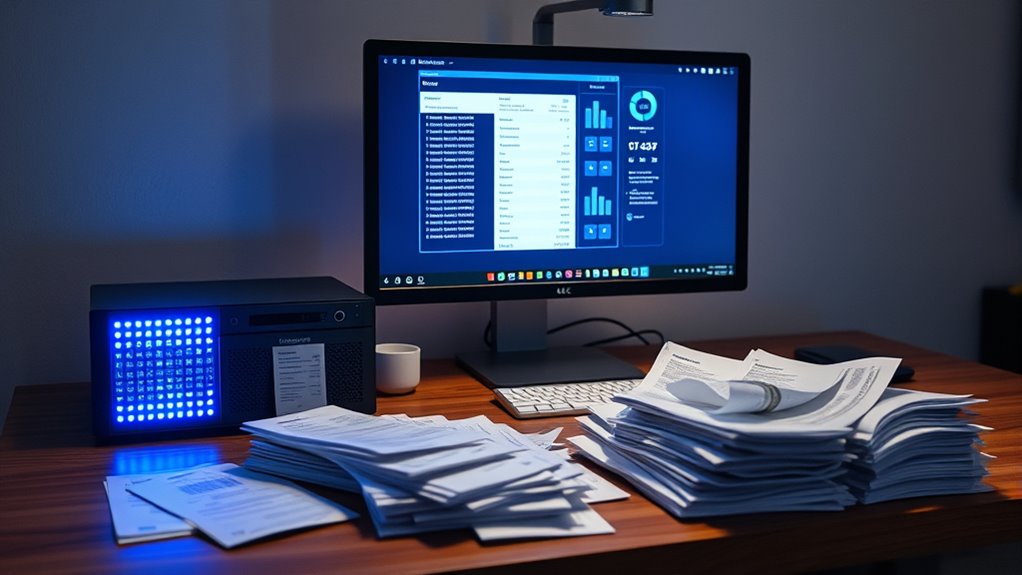
Integrating OCR (Optical Character Recognition) with home server automation creates a streamlined workflow for managing digital receipts. By connecting OCR tools directly to your home server, you automate the extraction of key data like vendor, date, and amount. This setup reduces manual entry and speeds up organization. You can automatically categorize receipts, update spreadsheets, or trigger notifications when new documents are processed. To maximize efficiency, consider these points:
Automate receipt data extraction with OCR and home server integration for faster organization.
- Use open-source OCR software for customization and cost savings
- Set up automated scripts to process new receipt images instantly
- Integrate with your existing home automation system for seamless workflow
This approach guarantees your receipt management becomes more efficient, accurate, and less time-consuming.
Ensuring Data Security and Privacy in Automated Receipt Management
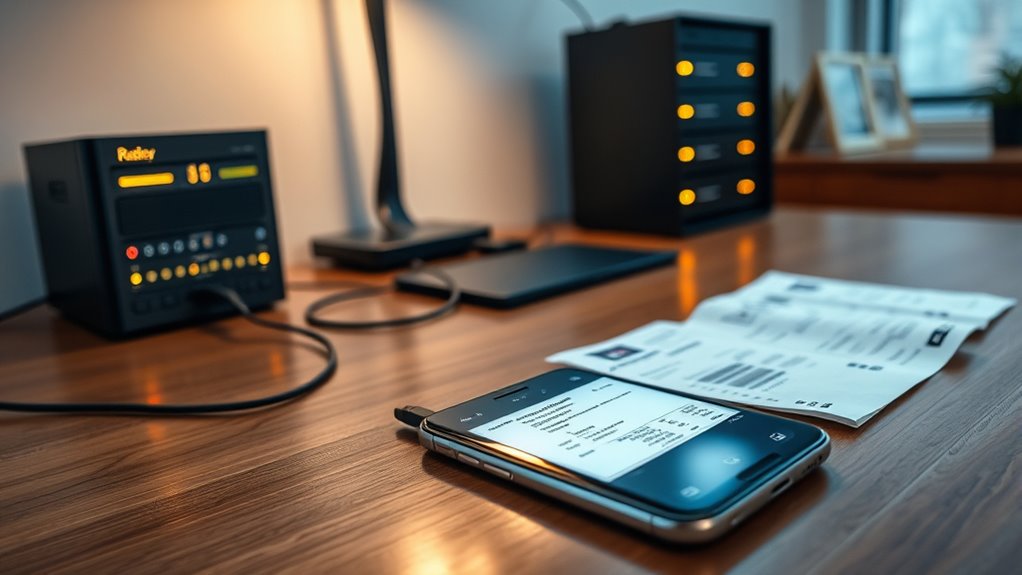
To safeguard your digital receipts, you need to focus on encryption and data protection measures that keep your information safe from unauthorized access. Implementing access control measures ensures only trusted individuals can view sensitive data. Additionally, staying compliant with legal standards helps you avoid penalties and maintain user trust.
Encryption and Data Protection
Since digital receipts often contain sensitive financial and personal information, implementing robust encryption methods is essential to safeguard this data from unauthorized access. Encryption ensures that even if someone intercepts the data, it remains unreadable without the decryption key. Use strong, industry-standard algorithms like AES-256 for securing stored receipts and TLS for transmitting data over networks. Regularly update your encryption tools to address vulnerabilities. Remember, encryption is only effective if keys are managed securely. Protect your keys with strong passwords and avoid storing them in easily accessible locations.
- Choose reputable encryption software with proven security standards
- Regularly update encryption keys and algorithms
- Keep backups of encrypted data in secure, offline locations
Access Control Measures
Implementing strong access control measures is essential to protect digital receipts from unauthorized viewing or modification. You need to restrict access to trusted users and devices, ensuring your data stays safe. Use passwords, two-factor authentication, and role-based permissions to limit who can view, edit, or delete receipts. Regularly update your security settings and review access logs to detect any suspicious activity.
| Access Control Feature | Purpose |
|---|---|
| Password Protection | Prevents unauthorized access |
| Two-Factor Authentication | Adds extra security layer |
| Role-Based Permissions | Limits user actions |
| Access Logs | Monitors activity |
| User Management | Controls user accounts |
Compliance and Legal Standards
Are you aware of the legal standards that govern how digital receipts must be handled? Compliance is essential to guarantee adherence to regulations like GDPR or CCPA, which set strict rules on data privacy and security. Failure to comply can lead to legal repercussions and damage your reputation. To stay compliant, focus on:
- Implementing encryption for data storage and transmission
- Regularly updating security protocols
- Limiting access to sensitive information
Troubleshooting Common Issues in OCR and Automation Processes
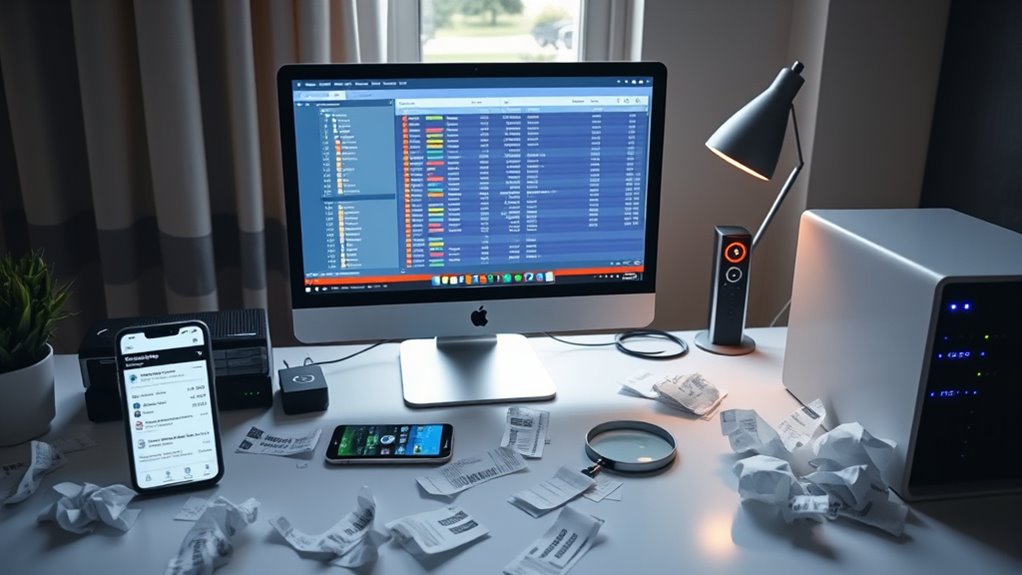
When troubleshooting issues in OCR and automation processes, it’s essential to identify the root causes quickly to minimize disruptions. Start by checking the quality of the scanned receipts; blurry or poorly lit images often cause misreads. Ensure your OCR software is up to date and configured correctly for your document types. If data isn’t being extracted accurately, review the recognition settings and language options. Automation failures might stem from incorrect scripting or broken integrations—verify each connection and script logic. Keep an eye on error logs for clues. Sometimes, the problem lies in file formats or storage paths. By systematically reviewing these areas, you’ll pinpoint issues faster, streamline your process, and keep your receipt organization system running smoothly.
Tips for Maintaining and Scaling Your Receipt Organization System

Maintaining and scaling your receipt organization system requires ongoing attention to guarantee it remains efficient as your volume grows. Regularly review your folder structure and naming conventions to keep them logical and consistent. Automate backups to prevent data loss, especially as your archive expands. As your collection increases, consider implementing filters or tags to categorize receipts quickly. To scale effectively, upgrade your hardware or storage solutions when necessary to handle larger data loads. Keep OCR settings optimized for accuracy, and periodically clean up misclassified or duplicate files to maintain clarity.
- Regularly review and update your organization system to adapt to new needs
- Automate routine tasks like backups and sorting to save time
- Invest in hardware upgrades or cloud solutions as your data volume grows
Frequently Asked Questions
How Can I Automate Receipt Backup Across Multiple Devices?
You can automate receipt backup across multiple devices by setting up a cloud storage service like Dropbox or Google Drive. Install the app on all your devices and configure automatic sync for your receipt folder. Use OCR tools to digitize receipts and save them directly to this folder. This way, every time you scan or download a receipt, it updates across all devices seamlessly, keeping your backups current and organized effortlessly.
What Are the Best Practices for Data Privacy With OCR?
When it comes to data privacy with OCR, you’re really walking a tightrope. Make sure you encrypt your data both in transit and at rest, so prying eyes can’t peek. Limit access only to trusted devices and apps, and regularly update your security protocols. Avoid storing sensitive info on cloud services if possible, and always read privacy policies. It’s better to be safe than sorry when handling personal data.
Can OCR Handle Handwritten Receipts Effectively?
You wonder if OCR can handle handwritten receipts effectively. While OCR technology has improved, it still struggles with handwriting compared to printed text. If your receipts are handwritten, you might need specialized OCR tools trained for handwriting recognition or consider scanning them clearly and using advanced software. Keep in mind, perfect accuracy isn’t guaranteed, so double-checking important details remains a good practice.
How Do I Update or Upgrade My Home Server Automation System?
While your questions focus on updating your home server system, consider how automation can simplify other tasks like organizing digital receipts. To upgrade, check your server’s hardware compatibility, update software to the latest versions, and explore new automation tools. Backup data first, then follow manufacturer instructions or community guides. Regular updates keep your system secure and efficient, ensuring it adapts smoothly to your evolving needs.
What Legal Considerations Exist for Storing Digital Receipts?
When you’re storing digital receipts, you need to consider legal rules like data privacy laws and record retention requirements. Make sure you comply with regulations such as GDPR or CCPA, especially if you’re handling sensitive info. Keep your receipts secure with encryption and access controls, and be aware of how long you’re required to keep records. Regularly review your storage practices to stay within legal boundaries.
Conclusion
Now that you’ve set up your system, imagine a future where your receipts are effortlessly organized, data is always at your fingertips, and chaos becomes clarity. With OCR and home server automation working seamlessly, you’ll reveal efficiency you never thought possible. But beware—hidden challenges may still lurk in the shadows. Stay vigilant, keep refining your setup, and watch as your digital receipt world transforms into an unstoppable, intelligent archive you can trust.
